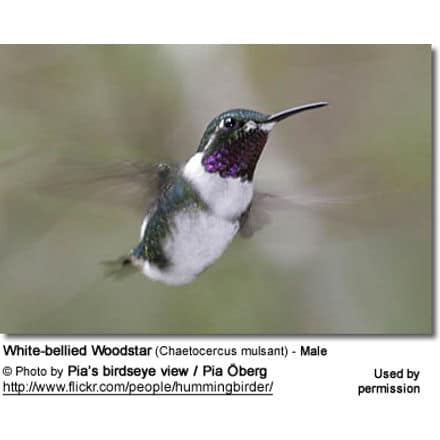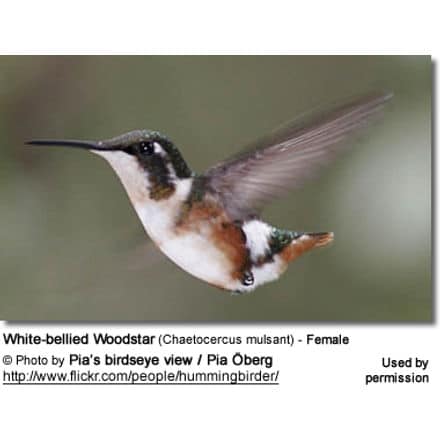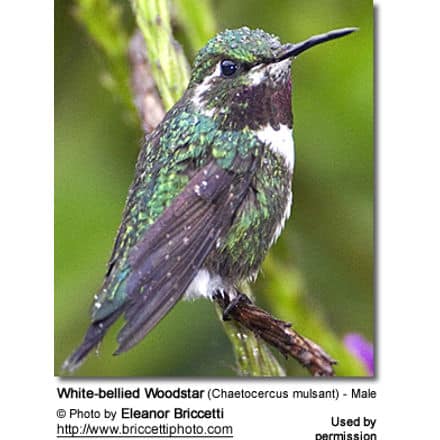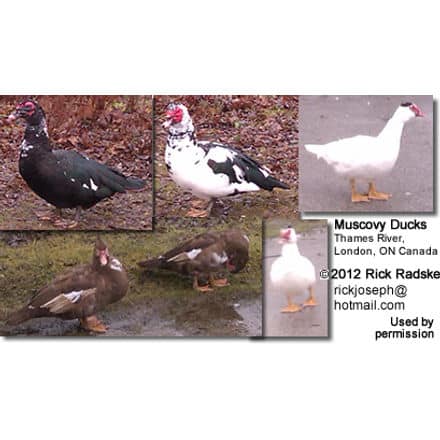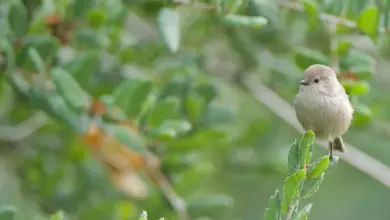White-bellied Woodstars
Hummingbird Information
Overview … Alternate (Global) Names
Description … Calls / Vocalizations
Breeding / Nesting … Diet / Feeding
The White-bellied Woodstars (Chaetocercus mulsant) – also known as Mulsant’s Woodstars – are small South American hummingbirds found in the mountains of Columbia south to parts of Bolivia.
They are comparable in size to the tiny North American Ruby-throated Hummingbirds, but their flight and general attitude are quite different. The Ruby-throated Hummingbirds are known for their fast and erratic flight patterns. They come and go in a flash, so to speak. The White-bellied Woodstars, however, fly very slow – quite similar to bumblebees.
Distribution / Habitat
The White-bellied Woodstars occur naturally in the moist forests of Central and Eastern Andes from Columbia, patchily south through Ecuador and Peru, to central Bolivia (Yungas of Cochabamba).
They inhabit humid montaine evergreen forests, tropical lowland evergreen forest, second-growth forests, heavily degraded former forests, woodlands, pastures and cultivated areas with trees.
They occur at elevations from 2,625 – 10,200 feet (800 – 3,100 meters) elevations – but are most common between 5,250 – 8,530 feet (1,600 – 2,600 meters).
Description
The slightly larger males measure about 3 – 3.25 inches (8 – 8.5 cm) in length – from the top of the head to the tip of the tail. Females are about 3 inches (7.5 cm) long. Their bills alone measure about 0.25 inches (1.7 cm).
The plumage is mostly glossy green, with white markings below.
Males have iridescent throat patches, which look red-purple in the right light, and short, spiky tails.
Females have instead a white throat (no throat patch), and orange flanks and chest bands.
Similar Species:
- Amethyst Woodstars have a longer tailsLittle Woodstars
Diet / Feeding
The White-bellied Woodstars primarily feed on nectar taken from a variety of brightly colored, scented small flowers of trees, herbs, shrubs and epiphytes. Even though they usually forage alone, these woodstars main join other hummingbirds in flowering trees.
They favor flowers with the highest sugar content (often red-colored and tubular-shaped) and seek out, and aggressively protect, those areas containing flowers with high energy nectar. They use their long, extendible, straw-like tongues to retrieve the nectar while hovering with their tails cocked upward as they are licking at the nectar up to 13 times per second. Sometimes they may be seen hanging on the flower while feeding.
Many native and cultivated plants on whose flowers these birds feed heavily rely on them for pollination. The mostly tubular-shaped flowers actually exclude most bees and butterflies from feeding on them and, subsequently, from pollinating the plants.
They may also visit local hummingbird feeders for some sugar water, or drink out of bird baths or water fountains where they will either hover and sip water as it runs over the edge; or they will perch on the edge and drink – like all the other birds; however, they only remain still for a short moment.
They also take some small spiders and insects – important sources of protein particularly needed during the breeding season to ensure the proper development of their young. Insects are often caught in flight (hawking); snatched off leaves or branches, or are taken from spider webs. A nesting female can capture up to 2,000 insects a day.
Males establish feeding territories, where they aggressively chase away other males as well as large insects – such as bumblebees and hawk moths – that want to feed in their territory. They use aerial flights and intimidating displays to defend their territories.
Breeding / Nesting
Hummingbirds are solitary in all aspects of life other than breeding; and the male’s only involvement in the reproductive process is the actual mating with the female. They neither live nor migrate in flocks; and there is no pair bond for this species. Males court females by flying in a u-shaped pattern in front of them. He will separate from the female immediately after copulation. One male may mate with several females. In all likelihood, the female will also mate with several males. The males do not participate in choosing the nest location, building the nest or raising the chicks.
The female White-bellied Woodstars is responsible for building the cup-shaped nest out of plant fibers woven together and green moss on the outside for camouflage in a protected location in a shrub, bush or tree. She lines the nest with soft plant fibers, animal hair and feather down, and strengthens the structure with spider webbing and other sticky material, giving it an elastic quality to allow it to stretch to double its size as the chicks grow and need more room. The nest is typically found on a low, thin horizontal branch.
The average clutch consists of two white eggs, which she incubates alone, while the male defends his territory and the flowers he feeds on. The young are born blind, immobile and without any down.
The female alone protects and feeds the chicks with regurgitated food (mostly partially-digested insects since nectar is an insufficient source of protein for the growing chicks). The female pushes the food down the chicks’ throats with her long bill directly into their stomachs.
As is the case with other hummingbird species, the chicks are brooded only the first week or two, and left alone even on cooler nights after about 12 days – probably due to the small nest size. The chicks leave the nest when they are about 20 days old.
Calls / Vocalizations / Sounds
Their calls are described as low “djurt” vocalizations. In flight, the male’s wings produce ringing sounds.
Alternate (Global) Names
Chinese: ????? … Czech: Kolibrík ostroocasý … Dutch: Witbuikboself … Danish: Hvidbuget Skovstjerne … Finnish: Piikkitöpökolibri … French: Colibri de Mulsant … German: Spitzschwanzelfe, Spitzschwanz-Elfe, Weißbauchelfe … Italian: Silvistella panciabianca, Stella dei boschi pettobianco … Japanese: shiroharachibihachidori, shiroharachibiohachidori … Norwegian: Hvitbukkolibri … Polish: brzeczek bialobrzuchy, brz?czek bia?obrzuchy … Russian: ???????????? ?????? ?????? … Slovak: cmelovec pestrý, ?me?ovec pestrý … Spanish: Colibrí de Mulsant, Coqueta Verde y Blanca, Rumbito Buchiblanco … Swedish: Vitbukad skogsstjärna
Hummingbird Metabolism and Survival and Flight Adaption – Interesting Information
Other Web Resources
Species Research by Sibylle Johnson
Please Note: The articles or images on this page are the sole property of the authors or photographers. Please contact them directly with respect to any copyright or licensing questions. Thank you.



